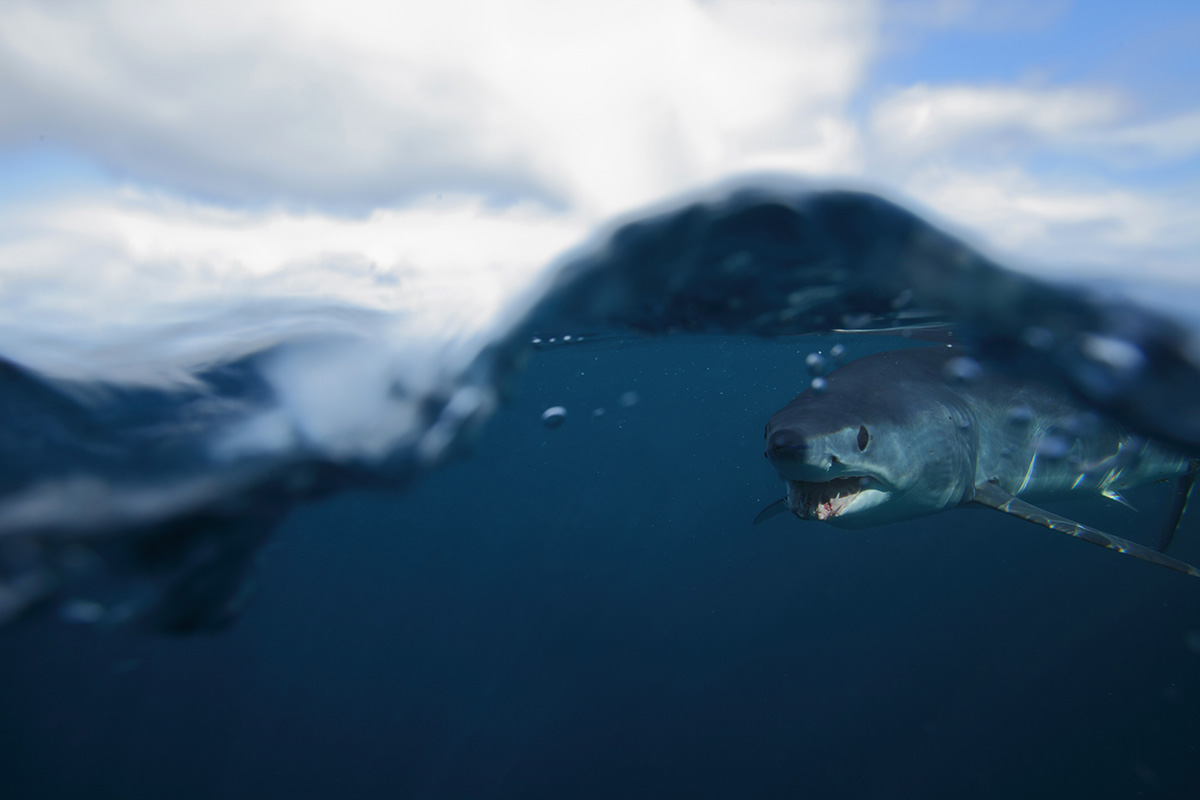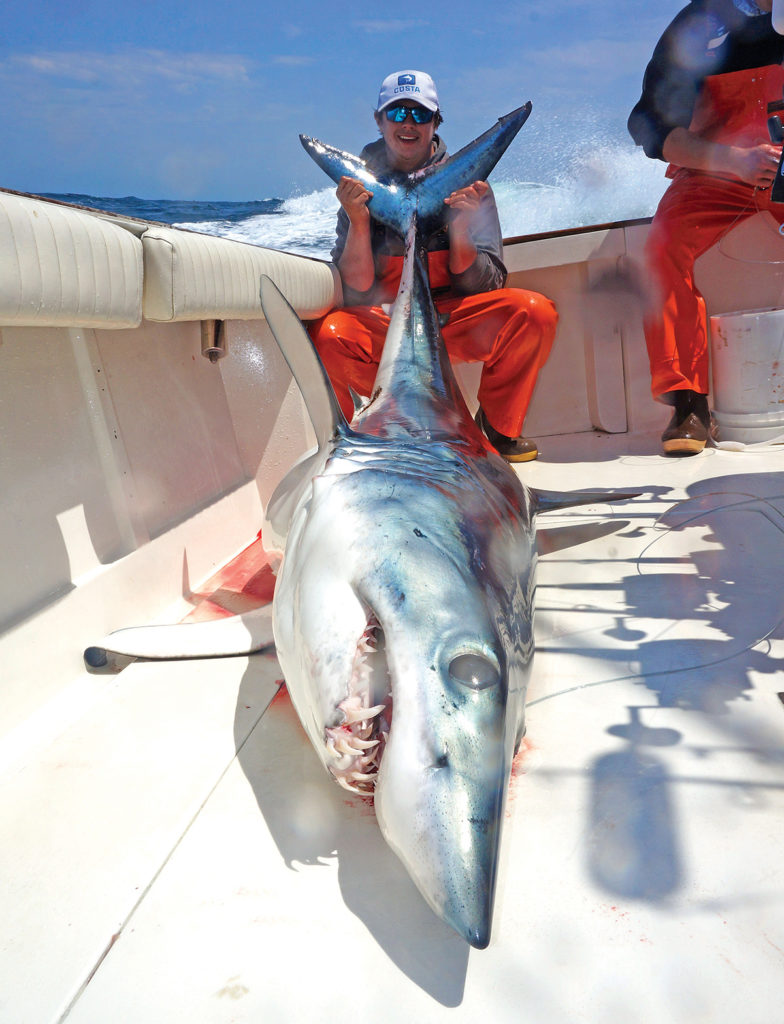
Be sure you are in compliance before targeting any sharks in federal waters beginning next season.
If you plan to target sharks in federal waters beginning January, 2018, whether it be makos, threshers, blues, browns or any other member of the shark family, then there is a list of changes that you’ll need to be well aware of before you begin planning that trip.
The National Marine Fishery Service (NMFS) recently published new requirements for recreational shark fishing in federal waters that are scheduled for implementation in early 2018. The proposed measures came about to protect the dusky shark stock that has been prohibited from lawfully being retained by both commercial and recreational anglers since 2000. According to NMFS one of the primary problems with the continued landing of dusky sharks, even with the prohibition in place, is the misidentification of dusky and other ridgeback sharks that are similar in appearance including bignose, Caribbean reef, Galapagos, night, sandbar and silky. However, the following ridgeback sharks are permitted to be retained: tiger, oceanic whitetip and smoothhound. The pending measures hope to address species misidentification, a lack of knowledge about prohibited shark species regulations and safe handling to minimize harm to accidentally-caught fish.
The northern range of dusky sharks is reported by NOAA to be south of Cape Cod, Massachusetts. Based on interviews of recreational anglers and charter boat captains, dusky shark encounters from New York to Texas range from never too rare these days, although there was a time back in the 60s and 70s that they were fairly common south of New England, from Long Island through the Mid Atlantic Coast. Interviews of recreational anglers and charter boat captains in select southeastern waters where dusky sharks are more prevalent indicated that they occasionally encounter groups of dusky sharks when targeting tuna similar to the observations by the commercial fleet. When such occurs they leave the area and fish for tuna in areas that are free of dusky sharks.
The following is a summary of the proposed recreational shark fishing measures proposed in federal waters in 2018.
HMS PERMIT SHARK ENDORSEMENT
An Atlantic Highly Migratory Species (HMS) Permit is required by recreational, charter head boat and/or for-hire vessels fishing in federal waters when targeting sharks, tunas, billfish and swordfish (pelagics). If you plan to fish in states waters (less than 3 miles from shore) for any of these species, then you will need to review and adhere to any specific, local regulations as you would any other inshore species. Fortunately, in most cases state regulations are consistent with the HMS Permit requirements. Going forward, any vessel recreationally-targeting sharks of any species in federal waters will be required to obtain a separate shark endorsement, with no additional fee, on their HMS Permit. HMS Permitted vessels can target other pelagics while targeting sharks, but they remain subject to all restrictions required with the endorsement.
TRAINING COURSE & QUIZ
An online shark identification and fishing regulation training course, followed by a short quiz, will be required in order to obtain the HMS Permit Shark Endorsement. In preparation for the quiz, NOAA has updated some of its reference materials (placards) providing details concerning dusky sharks, other prohibited and permitted shark species which may be encountered in federal waters, and recommended shark catch and release methods. (See Sidebar)
The NOAA placards provide a wealth of details concerning dusky sharks and other shark species that is a vast improvement over what was previously available in an attempt to prevent misidentification of dusky sharks and other similar species. As with any fish, “If you don’t know, let it go!”
CIRCLE HOOK REQUIREMENT
Mandatory use of non-offset, non-stainless steel circle hooks will be required when recreationally fishing for sharks south of the 41043’ N latitude line (demarcation line) except when fishing with flies or artificial lures. The demarcation line is slightly north/south of Chatham, MA which covers most of The Fisherman’s readership area. Circle hooks will be required when recreationally shark fishing with live or dead bait in federal waters south of the demarcation line from Massachusetts to Texas.
One can utilize J-hooks with flies or artificial lures to recreationally fish and retain legally permitted sharks. Flies and artificial lures typically consist of J-hooks when trolling or vertical jigging for other pelagics, and since they may result in hooking into a shark as bycatch, their use remains permitted. However, if you are using a J-hook with live or dead bait while targeting other HMS Permitted species, and you hook into a shark, it is required that the shark be released in order to remain in compliance with the permit. If the HMS Permit holder does not have the shark endorsement, all sharks are required to be released regardless of hook type.
Proper Shark Handling & Release
Hooking, battling, measuring, retaining or releasing sharks and other large pelagics is subject to many variables and is much different than hooking into and reeling in a striped bass, for example. The equipment and/or rod and reel you are using needs to be appropriate for the size of the sharks you are targeting. Appropriately-sized gear serves to reduce the fight time and subsequent stresses on the shark so that if it is not being retained the angler and crew may conduct a quick release to ensure the highest level of survivability. As with other target species, light equipment generally leads to longer fight times that can exhaust the shark increasing the potential for the shark to suffer physiological damage or ultimately perish if released.

Once a shark is brought alongside the boat, and proper identification of the species has been made, one needs to measure the shark to make sure it is of legal size if the intention is to retain the shark. (Refer to the HMS Recreational Compliance Guide, available at http://www.nmfs.noaa.gov/sfa/hms/compliance/guides/documents/hms_rec_compliance_guide_total.pdf, for authorized species, bag limits an seasons.)
Whether targeting a shark or any other HMS permitted species utilize a measuring device that allows you to measure the fork length of the fish in the water to assess whether it can be legally landed. Further, do not use a gaff if the fish is not going to be retained. To make measuring of sharks and other pelagics while still in the water a simpler task, I have one foot increments noted on the side of my vessel from the bow of the boat to amidships. It should be further noted that, “An Atlantic HMS species that is not retained must be released in a manner that will ensure maximum probability of survival, but without removing the fish from the water.” Therefore, don’t remove the fish from the water to take a photograph unless you are retaining the fish. To conduct such is a permit violation, not good for the health of the shark and can be dangerous to the vessel and/or anglers onboard.
If a shark is determined to be released, whether an ineligible species, too small for harvest or if it was simply determined not to be retained, NOAA recommends “when releasing the shark, allow water to flow over the gills by moving the shark forward in the water, or by positioning the shark so the current flows toward the head of the animal, until its energy returns.” This can be accomplished with a good drift of current or by engaging the engines with the boat slowly moving forward. This keeps the water moving over the gills and provides better control of the leader and shark. This process should be continued until it is determined that the shark can safely swim off under its own power.
| NOAA SHARK VIDEO |
|---|
| In 2017, NOAA released its “Atlantic Recreational Shark Fishing: Handling and Release of Prohibited Species” video. The video discusses much of the new requirements for anglers looking to target sharks in federal waters. The full video can be found by visiting The Fisherman Magazine’s video library at http://www.thefisherman.com/index.cfm?fuseaction=feature.display&feature_ID=1839&ParentCat=9. |
Cut the Leader or Remove the Hook?
When releasing a shark, NOAA recommends to attempt to remove the circle hook with a de-hooking device, or if appropriate cut the leader as close as possible to the hook, which should rust out over time (The use of stainless-steel hooks is prohibited.). Which method is chosen by angler and crew needs to be a judgement call based upon the size and temperament of the shark as well as the experience of the anglers on the fly.

De-hookers work well on small sharks as well as some larger sharks that remain calm next to the boat. Large or “unruly” sharks run the risk of biting the person using the de-hooker when their hand gets near the shark’s mouth as well as hitting their head or body against the hull of the boat and thereby causing damage to shark, boat or both. Oftentimes in this scenario it is simply safer to cut the leader as close as possible to the hook. Bolt cutters may also be used to cut the hook so that it can more readily rust and fall out, but again this works best on smaller or calmer large sharks.
I carry both smaller de-hookers noted in the NOAA placards as well as a heavy duty, 5-foot long de-hooker that will not as readily bend and keeps hands a safe distance from sharp teeth.
Good luck on the water and be safe with your catch and release methods.
| NOAA PLACARDS |
|---|
|
GENERAL SHARK IDENTIFICATION: http://www.nmfs.noaa.gov/sfa/hms/species/sharks/documents/shark_id_placard_532017_web.pdf PROHIBITED SHARK IDENTIFICATION: http://www.nmfs.noaa.gov/sfa/hms/species/sharks/documents/prohibited_shark_id_placard_5302017_web.pdf NOAA BEST CATCH AND RELEASE METHODS: http://www.nmfs.noaa.gov/sfa/hms/compliance/tournaments/outreach/cc_brochure_web.pdf |




